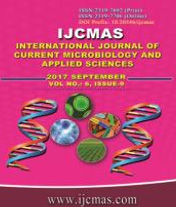


 National Academy of Agricultural Sciences (NAAS)
National Academy of Agricultural Sciences (NAAS)

|
PRINT ISSN : 2319-7692
Online ISSN : 2319-7706 Issues : 12 per year Publisher : Excellent Publishers Email : editorijcmas@gmail.com / submit@ijcmas.com Editor-in-chief: Dr.M.Prakash Index Copernicus ICV 2018: 95.39 NAAS RATING 2020: 5.38 |
Candidal lower urinary tract infection (UTI) is quite frequently seen in association with indwelling catheters, and may originate from the gastrointestinal or genitalbiota. The frequency of urinary tract infections (UTIs) due to Candida spp. is increasing and these infections are now being the most common clinical finding, particularly in hospitalized patients. It is common in the patients admitted in intensive care units, individuals with multiple predisposing factors, including diabetes mellitus, indwelling urine catheter, long term exposure to antibiotics and immunosuppressive therapy. Non albicans Candida species appear better adopted to the urinary tract environment and are more resistant to antifungal drugs compared to C. albicans. Early and prompt diagnosis, proper treatment and prevention of candiduria due to biofilms pose a major challenge for microbiologists and clinicians worldwide. The aim of the study was to detect biofilm producing ability of various Candida species isolated from Catheterized and Non-catheterized candiduria patients hospitalized in NRI General Hospital. A total of 100 Candida spp isolates from both Catheterized and Non-catheterized patients with candiduria were taken for the study. The Candida spp isolates were identified by using conventional methods, rapid identification by HICHROM agar and their ability to produce biofilm was detected by the tube method. Antifungal susceptibility testing of all Candida isolates was performed using the disk diffusion method. Statistical analysis was done by Statistical Package for the Social Sciences (SPSS) software version 20. A total of 100Candida spp were isolated from 37 catheterized and 63 Non-catheterized patients. Among them 84 were Non Albicans Candida (NAC).Biofilm was produced by 48(48%) isolates. Most of Biofilm producing Candida species were resistant to clotrimazole (26%) and fluconazole (25%). The present study suggests an increasing prevalence of Non Albicans Candida in urine samples and also shows them to be strong biofilm producers when compared to C. albicans. Biofilm formation also helps the organism to overcome host defenses and exists as a persistent source of infection. Biofilm production found to be of more significance to Non Albicans Candida than C. albicans. Thus more remains to be determined about biofilms formed by the Non Albicans Candidaas they are now, frequently encountered isolates in candidurias.
 |
 |
 |
 |
 |